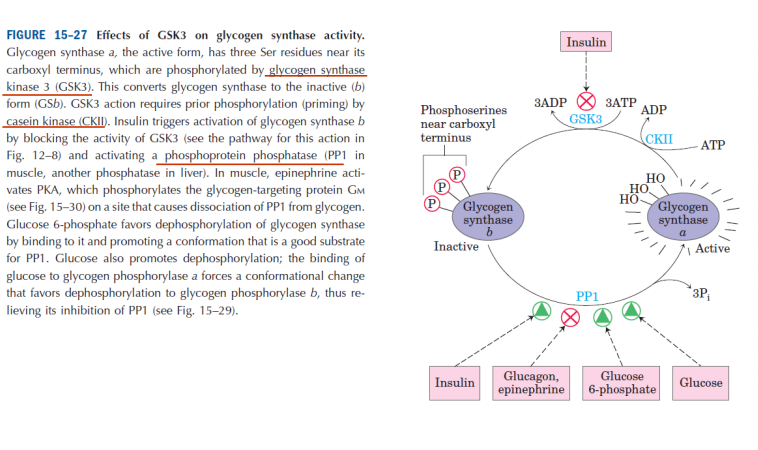5

FIGURĘ 15-27 Effects of GSK3 on glycogen synthase activity.
Glycogen synthase a, the active form, has three Ser residues near its carboxyl terminus, which are phosphorylated by glycogen synthase kinase 3 (GSK3). This converts glycogen synthase to the inactive (6) form (GS6). GSK3 action requires prior phosphorylation (priming) by casein kinase <CKII). Insulin triggers actiyation of glycogen synthase b by blocking the activity of GSK3 <see the pathway for this action in Fig. 12-8) and actiyating a phosphoprotein phosphatase (PP1 in muscle, another phosphatase in liver). In muscle, epinephrine acti-vates PKA, which phosphorylates the glycogen-targeting protein Gm (see Fig. 15-30) on a site that causes dissociation of PP1 from glycogen. Glucose 6-phosphate favors dephosphorylation of glycogen synthase by binding to it and promoting a conformation that is a good substrate for PP1. Glucose also promotes dephosphorylation; the binding of glucose to glycogen phosphorylase a forces a conformational change that favors dephosphorylation to glycogen phosphorylase 6. thus re-lieving its inhibition of PP1 (see Fig. 15-29).
Phosphoserines near carboxyl terminus
3ADP (^9 3ATP
GSK3
ADP
ATP
Glycogen
synthase
Inactive
Active
Insulin
Glucagon,
epinephrine
Glucose
6-phosphate
Glucose
Wyszukiwarka